Most people probably have at least heard of or seen a Japanese tea set in their lifetime. You might be curious about the creation of these tea sets, given their intricate design and exquisite Asian craftsmanship.
Japanese antique tea sets have been around for a long period, and people continue to use and collect them even now. They are either made of porcelain or clay and have hundreds of themes with Japanese characters and patterns.
Antique Japanese tea sets range in price from a few hundred to several thousand dollars, depending on several factors.
Suppose you want to learn about antique Japanese tea sets in this article, including what to look for and how to value them. In that case, we’ll look at the most valuable antique Japanese tea sets and how to recognize and pass them through an authentication process.
So if you own Japanese tea cups, pour yourself a cup of coffee and keep reading.
Table of Contents
Brief History of Antique Japanese Tea Set
Since the eighth century, Japan has been accustomed to drinking tea. They went to China to learn about their culture and way of life but returned with tea. Due to this, it eventually became a beverage of the religious elite before spreading to the royal and noble class.
In Japan, drinking tea is a long-standing custom that started when Buddhist monks used it while meditating. Aristocrats later utilized it to demonstrate their culture and wealth during the Tang Dynasty.
Tea time had become widespread in everyday houses by the 17th century. There were even tea rooms in many homes.
Since the middle of the 20th century, they have endured and developed into a Europe and the Western world obsession. Japan’s cultural approach to the hot cup of tea, such as the Japanese tea ceremony, was one factor that contributed to an enduring era of tea consumption.
The Japanese Tea Ceremony, which includes drinking green tea, quickly expanded to both towns and villages, becoming what it is today. When it was at its height, making tea while interacting with people required a sequence of precise gestures.
After the European encounter with the island nation of Japan, dynasty Japanese teacups and other Japanese pieces began making their way to Europe beginning in the 1500s.
However, more contemporary antiques from the 19th or the first decade of the 20th century are far more prevalent today.
Due to the import regulations during that period, Japanese products like tea sets manufactured between 1891 and 1921 will have a Nippon identity.
Dynasties of Antique Japanese Tea Set
Since collectors are more interested in this information, it is crucial to note the tea cup dynasty, its makers, and patterns. In addition, these attributes can help indicate what city the cups were manufactured in.
Suppose you are not proficient in the various written dialects of Japanese, and certain teacups may be marked with Japanese characters designating these many dynasties. In that case, you should get your pieces evaluated and translated.
Here are some of the different dynasties that make Japanese tea cups.
Edo: 1603 – 1867
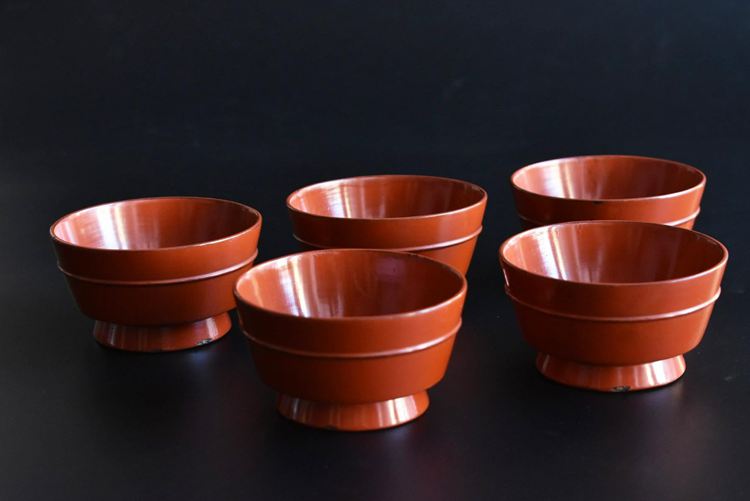
Showa: 1926 – 1988
Momoyama: 1573 – 1603
Meiji: 1868 – 1913
Taisho: 1913 – 1926
Vintage Patterns of the Antique Japanese Tea Set
Below are some early manufacturers of the antique Japanese tea set. You might also see manufacturer markings from Jyoto, Mikado, Saji, Ardalt, Sango, and Noritake companies alongside “Made in Japan” and “Made in Occupied Japan” marks.
Japanese tea sets from antiquity used to have many different patterns and designs. The city of origin of the set makes it much simpler to identify the patterns than the patterns themselves.
Here are a few of the most typical designs found on old Japanese tea sets.
Kutani Pieces
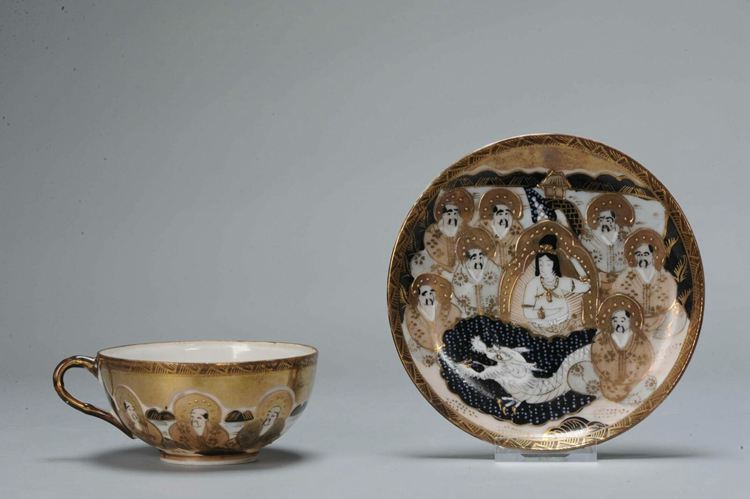
The production of Kutani pieces began in the middle of the 17th century and is still going strong now. Up to 1868, tea sets bore the Fuku mark.
It possessed the Kutani mark from 1868 to 1912, frequently used in conjunction with Japanese emblems signifying Great Japan. Later settings up until World War II were identified as Kutani and Japan.
Kutani tea sets usually have elaborate decorations.
Chubu Pieces
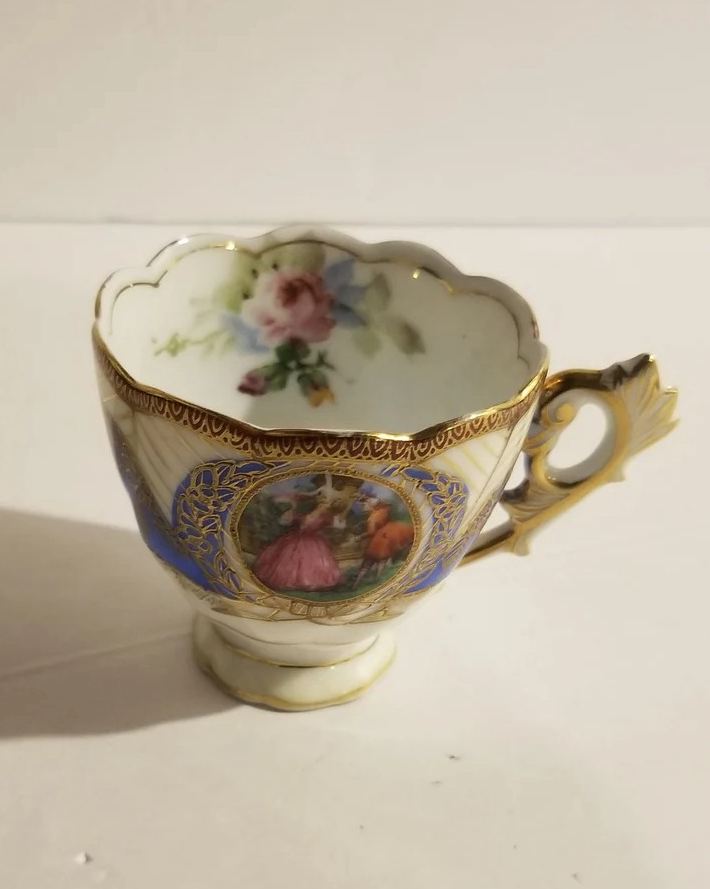
In the 1950s, the U.S. was the leading destination for Chubu tea sets exports. Most were marked with the “Made in occupied Japan” stamp, which was necessary following the war from 1945 to 1952.
Bizen Pieces
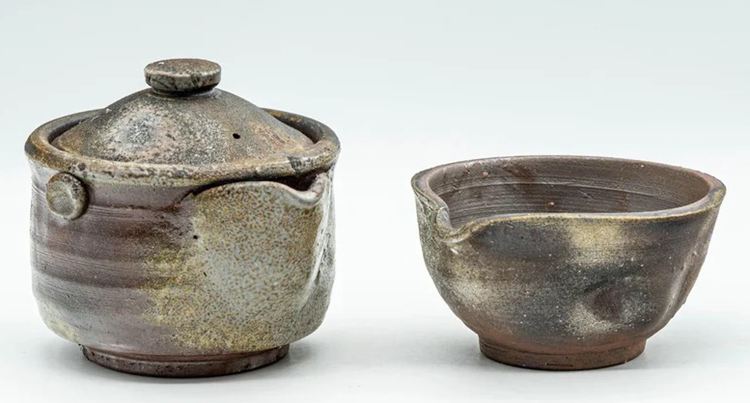
Japanese history’s Heian era is when the Bizen artifacts date back. It contains pottery that appears to be rough. Most of them are unglazed, which makes this set simple to hold.
Bizen sets frequently included humorous figures of gods, birds, and other animals.
Satsuma Japanese Pieces
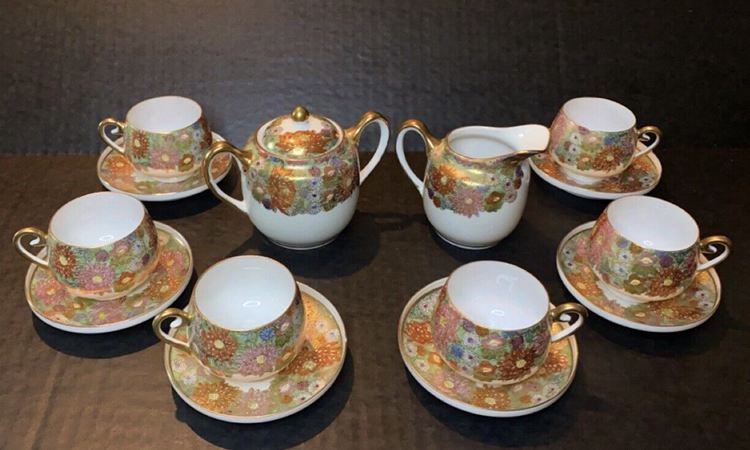
Typically, satsuma sets included depictions of Japanese craftsmen painting vases. In addition, the set had an overall shine of cracked ivory.
Earthenware is a sort of clay pottery that is used to make satsuma sets. Tea sets of Japanese porcelain weigh less, glow less, and make less noise when tapped.
There are two different varieties of Satsuma sets: the older style with a beautifully crackling clear graze and a relief design, which is the original sort with a heavy dark glaze. Later designs featured delicate floral patterns.
Moriage Pieces
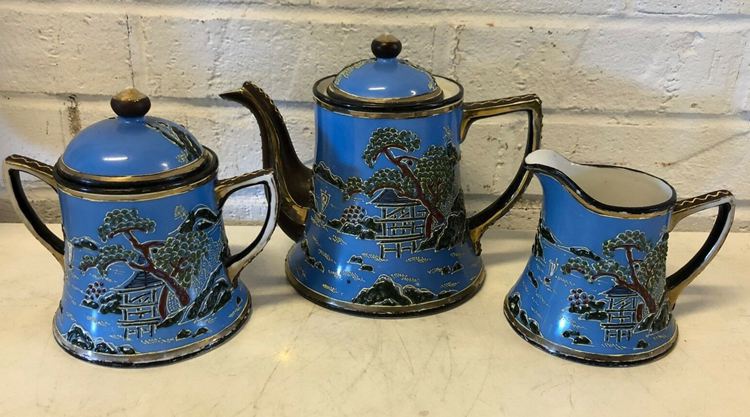
Clay is applied to specific items during the Moriage process. The goal is to build a foundation for complex designs that have been slightly elevated. It could be anything about the product, such as trees or a gold leaf. It’s a relatively simple addition to any tea set.
Moriage patterns have been utilized in Japanese tea sets for many years. Raised styles and designs are produced on clay pots using this style.
Moriage objects are distinctive and frequently painted in vivid hues. Some have a gold leaf added.
Many following producers reproduced the dragon designs found on Dragonware Moriage pieces.
Imari Pieces
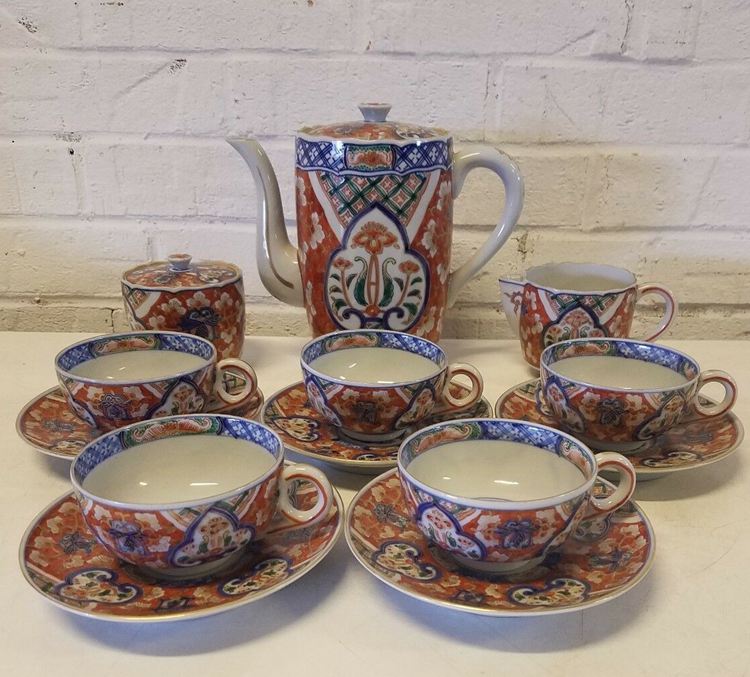
Imari tea sets frequently feature elements of nature, such as flowers or leaves. Additionally, they often had white ground with an underglaze blue and rusty red.
Most Valuable Antique Japanese Tea Sets
We have discussed the different styles and dynasties of antique Japanese tea sets; we shall be looking at some of the most valuable Japanese tea sets you can find on the market.
13. Pre-World War II Antique Tea Set
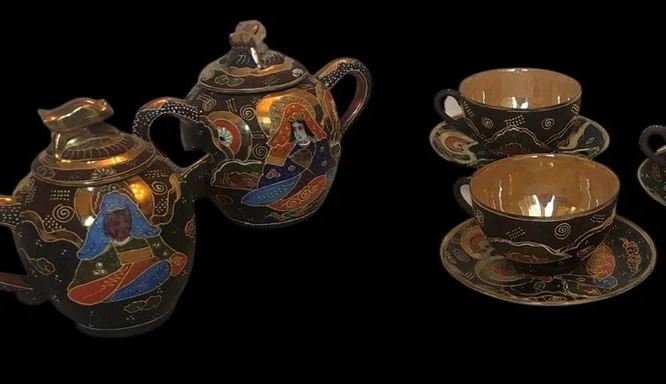
The period between 1921 and 1941 is when this lovely ancient tea set, which was hand-painted, was made. There are no nicks or chips anywhere, showing very little wear.
Each tea cup has a lustrous finish and a great black background highlighting the lovely hand painting. The teapot, creamer, and 6 cups are all included in this set. The creamer and teapot both have a back stamp.
12. Antique Moriage Dragonware Tea set
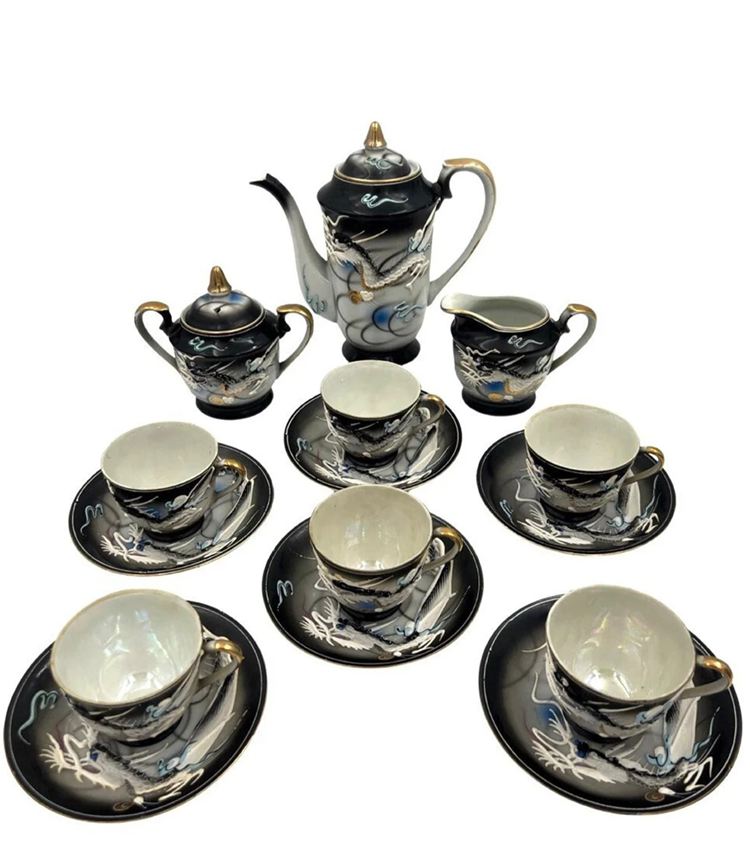
A Hand Painted Moriage (raised enamel) Dragonware 1950s Mid Century Tea Set. 6 cups, 6 saucers, 1 teapot, 1 sugar bowl, and 1 creamer are included in the service. Beautiful Full Set in Excellent Condition with gold accents and black, grey, white, and blue colors. The tallest tiny teacups are 2 inches—interiors of white Lusterware cups. There is slight wear on some memorials and within a few teacups.
Zero crazing, chipping, or cracks. Fantastic for Asian home decor, millennial, bohemian, eclectic, etc.
11. Antique Japanese Tea Set (1900s) Hand-Painted
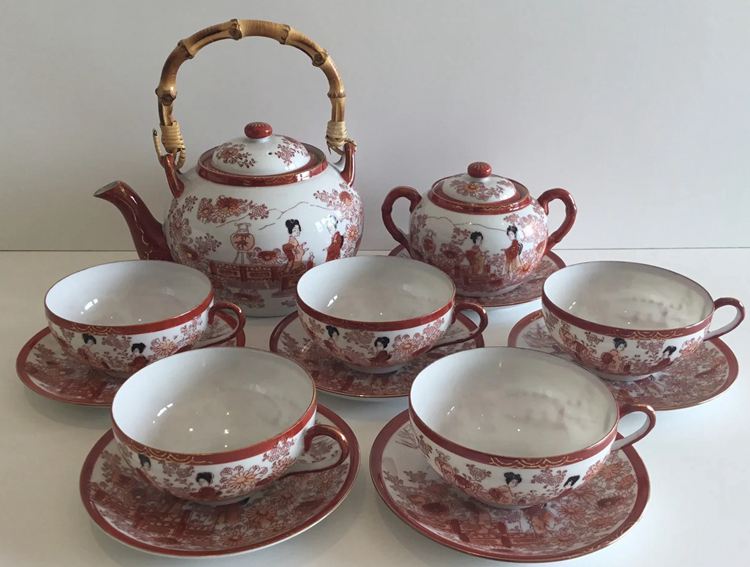
The lovely porcelain set with exquisite hand painting is of genuine Japanese high quality: genuine porcelain, rare set, and perfect condition.
It is a beautiful antique Japanese teacup set from the early 1900s, with sugar, saucer, and cup in traditional “old” oriental shape. A human figure is shown in a beautiful, colorful, and intricate artwork with cherry blossoms and lovely garden flowers in the backdrop.
Beautifully designed with red and white trim, the magnificent wide tea cup, sugar, and saucer are enormous.
10. Kutani Geisha Girl Tea Set
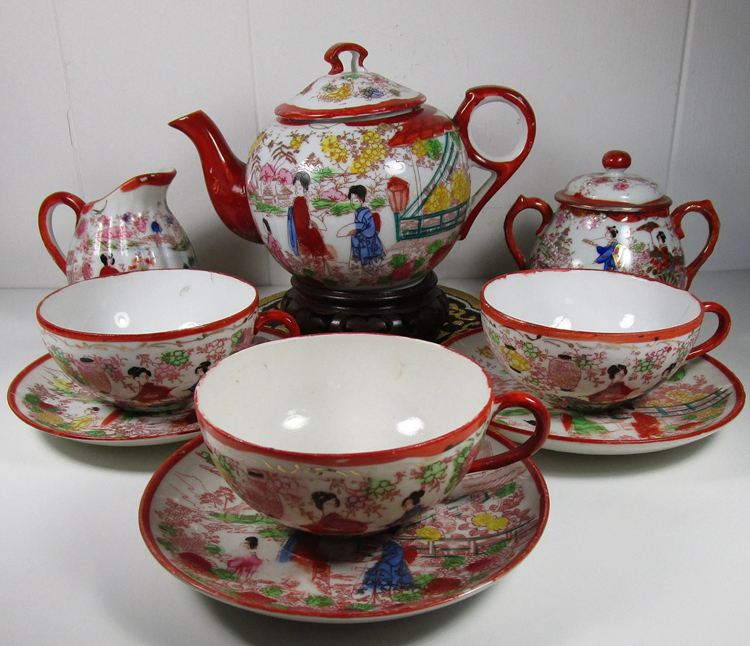
Vintage Japanese Eggshell Porcelain Kutani Geisha Girl Tea Set with Hand Painted Teapot, Tea Cups, Saucers, Sugar Bowl, and Creamer.
The one in the picture above has a little chip on the creamer spout and cup handle of three identical cups, three identical saucer sets, and typical wear associated with the aging of most things. This piece is a fantastic collectible set that is difficult to find.
9. Antique Japanese Porcelain Tea Set
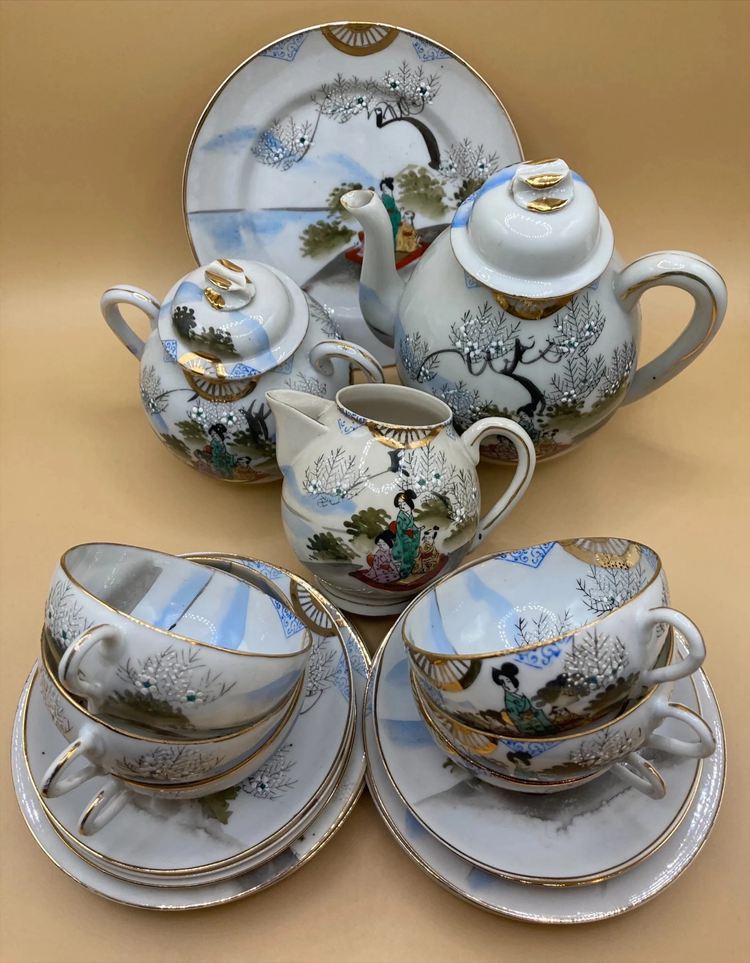
Six-piece vintage Japanese eggshell porcelain tea set decorated by hand.
Rare tea sets made of very excellent porcelain made in Japan, around 1910–1920. The tea set has a nice decoration; house gift tableware for decorating a home
Japanese design themes. Both the exterior and interior of tea cups are ornamented.
This item is an incredible investment for collectors of vintage goods and a lavish housewarming or tea party present.
8. Dragon Enamel Japanese Tea Sets
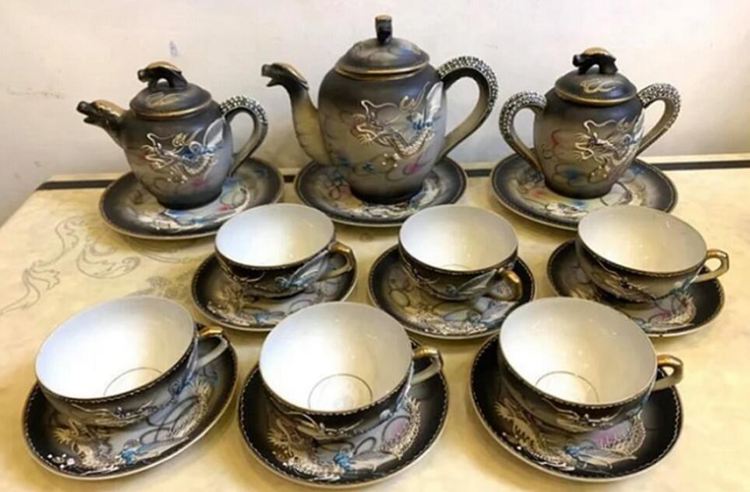
This Japanese teapot set is unique in its “beautiful shape and style, constructed of ceramic, terracotta,” making it ideal as a gift or for living room décor.
The cup contains a picture of a little girl. It makes the light appear dark when it is illuminated. Elegant and stunning etched enamel dragon shape. High-value collectible gold textures.
7. Takito Company Japanese Tea Sets
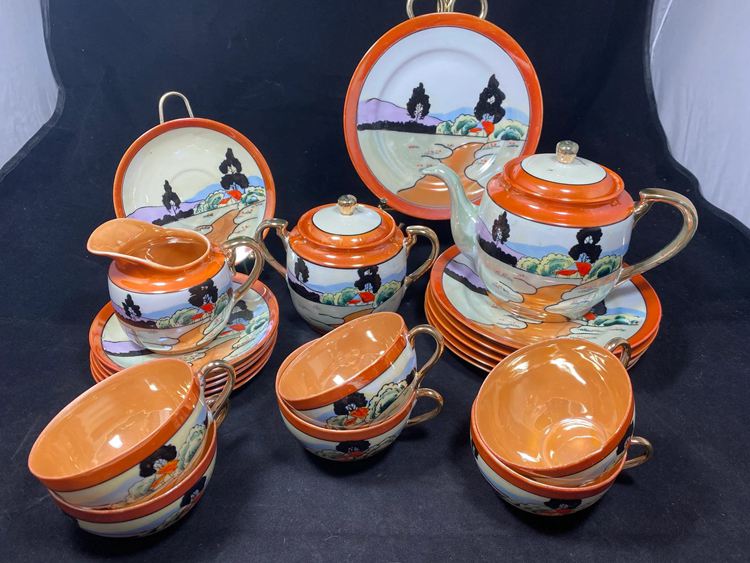
These tea cups were trendy from the late 1920s to the early 1930s. Their ” TT ” shows that they are a product of the Takito Company.
The Takito company, which existed from 1880 to 1948, is mainly recognized as one that specialized in the Lustreware style of decorating, a style that originated from the Noritake firm.
This piece can still fetch over a hundred dollars despite so many years of existence.
6. Hand Painted Japan Tea Sets
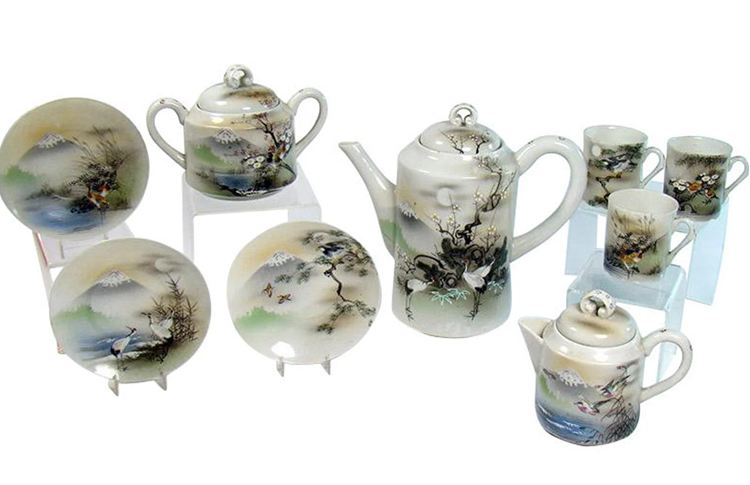
The high kaolin content in this lovely Japanese porcelain tea set from the 1920s makes the porcelain paper-thin and almost translucent. The pot, creamer, sugar, three cups, and three saucers are among the twelve items in the set.
Only a very fine hairline in the teapot lid can be seen as a fault. It is a beautiful set aside from that.
The artwork features beautifully crafted hand-painted cranes, mountain vistas, flying birds, an
Most of the pieces have a Japanese signature on the bottom or back.
Value:
5. Satsuma Moriate Japanese ceramic tea service
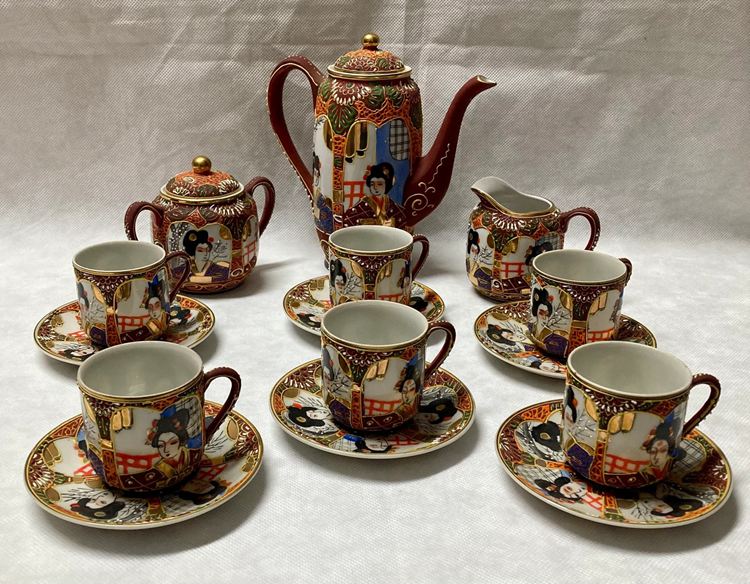
Stunning Japanese tea service made of pottery The name of the original production location, the Shimazu clan’s southern territory on the island of Kyushu, is Satsuma Moriage, or Satsuma Porcelain.
The Satsuma lord decided in 1855 to encourage manufacture for the international market, and they were shown for the first time in 1867 at the Universal Exhibition in Paris with outstanding success.
The proposed tea service is an attractive and sophisticated example of the Moriage method, which refers to glazed sections in relief. The unique aspect of the service is that each cup has a lithograph of a geisha on the bottom.
4. Antique Japanese Kutani 1000 Faces
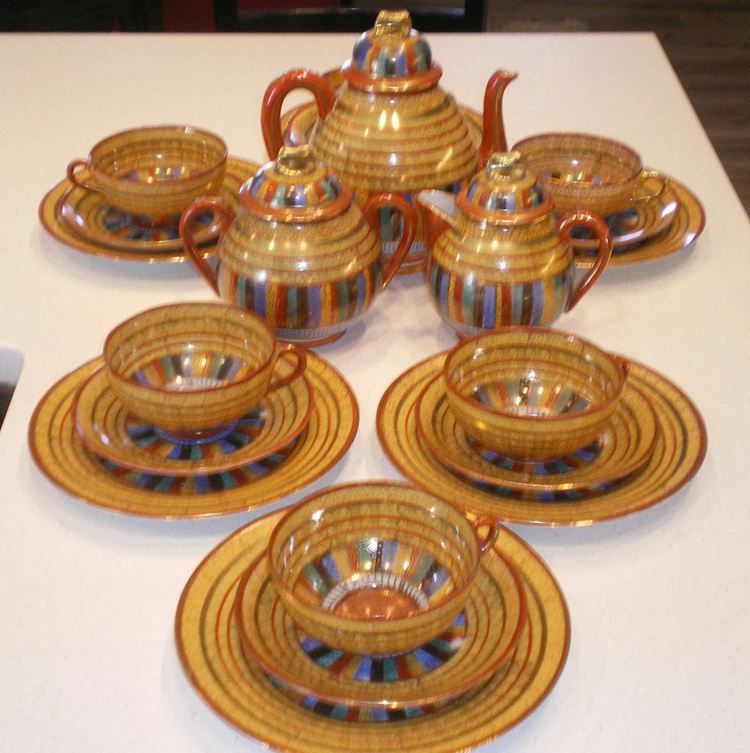
An actual artist hand-painted each piece of this collection. Each of them wears a distinctive expression. Inside each shade of black, there are tiny motifs in the colors orange (Imperial red), green, blue, black, and yellow.
This pattern then repeats itself. There are tiny cherry blossoms plated in gold all around each item. Gold gilding is used for all of the line and design work. It is ornate and intricate.
Three cherry blossoms are pressed together to form a handle as the finial on top of the pot, creamer, and sugar. They are all gilded in solid gold. On the base, each one is inscribed. This piece was among the early Japanese creations in the 1920s.
3. Lithophane Geisha Girl Teacups
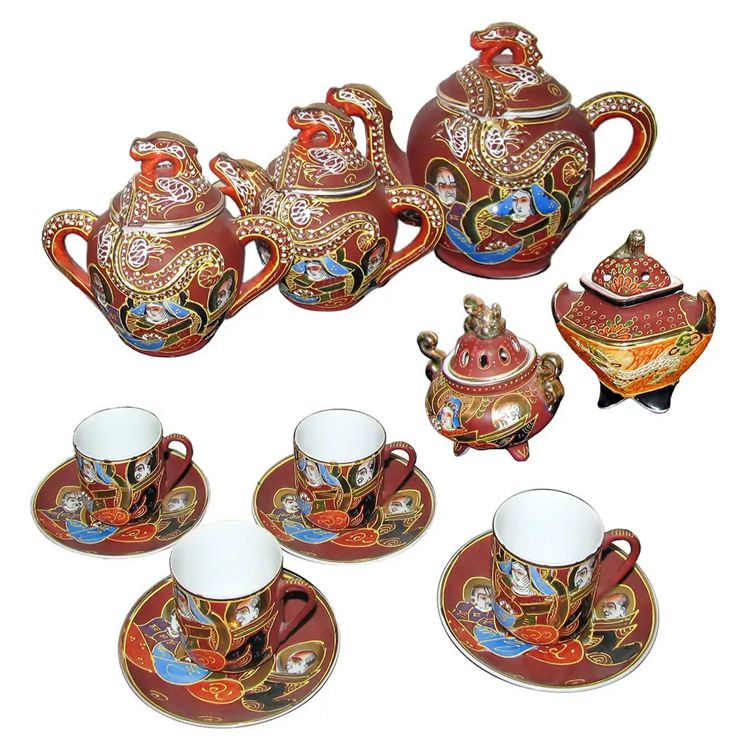
Elegant antique Satsuma Dragon tea set made of Moriage Lithophane Geisha eggshell fine porcelain; the bottom of each cup features a lithophane image of a Geisha girl. Dragon Knobs are used as decorations on the lids.
Hand-painted in the so-called Moriage colors of brown with white spots, gold, rust-orange, blue, green, and black. They were made in the 1950s and 1960s when décor colors were more robust and vivid.
According to the seller, the item is in excellent condition with no chips or cracks; handmade pieces will naturally have some imperfections.
2. Japanese Gilt and Painted Tea and Dessert Serving Set
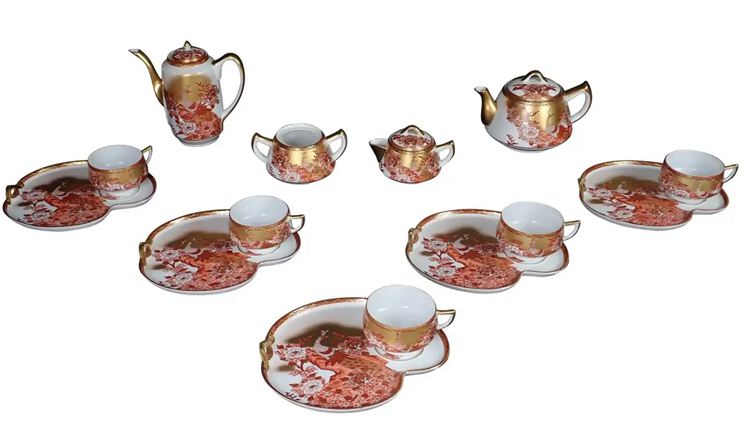
Here is another valuable Japanese dessert and tea service set from the 1930s with gold paint—a hand-painted service set with a peacock and floral design.
Five snack sets with handled dishes and tea cups, lidded tea and teapots, covered creamer, and a sugar set.
On the interior bottoms of the teacups is a raised, etched image of a geisha. It also has a maker’s mark.
1. Satsuma Japan Made Tea Cups
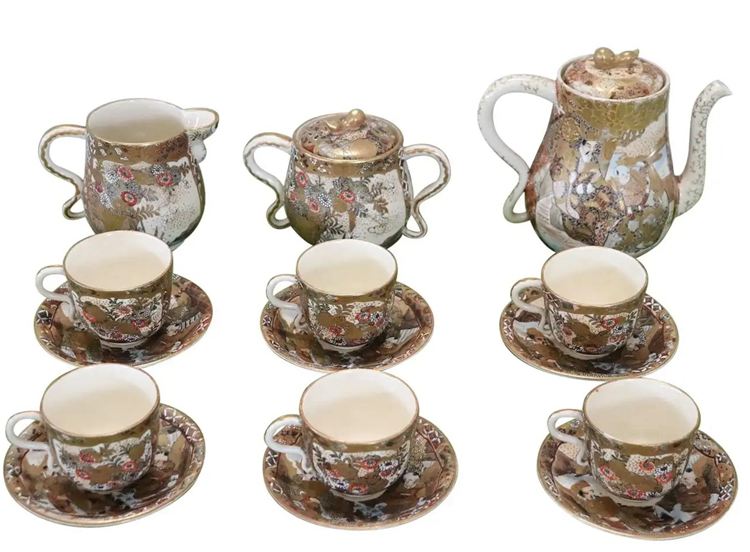
Another tea set on the list of most valuable Japanese tea sets is this beautiful 15-piece Satsuma Japanese teapot and cups from the 1880s with hand-painted gold accents.
One teapot, sugar, milk jug, and six saucers make up the entire set for serving six persons at the table. They have a refined gold decoration, made in Japan, porcelain of superior quality, and are a highly collectible item.
How to Identify Valuable Antique Japanese Tea Set Markings
Antique Japanese tea sets are different from the tea sets we are more accustomed to today in so many different ways.
When examining old Japanese tea sets, the year of manufacture is a crucial factor to consider. Japan started sending some of its exquisitely constructed tea sets to Europe in the 1500s.
Japanese characters plainly stated that the creation was in Japan—and, more significantly, during which dynasty—were added to any export of Japanese items.
You may have the experience to guide you through the complicated process of valuing an old Japanese tea set. First, you would try to ascertain the date of production, the material, the design, the state of the item, and the set’s completion to determine the value.
As with many antiques, items in mint condition will always get a higher value.
Given the prevalence of fake goods, requesting a certificate attesting that the product has been put through an authentication procedure is crucial.
Another critical value determinant for antique Japanese tea service sets is the maker’s mark. So in the following sections, we shall see how the markings can affect the value of your Tea service set.
Manufacturers Marks
Even though there were hundreds of producers, some are more well-known and valuable than others. Although there are hundreds of these, they can frequently be distinguished by their unique back stamps.
Despite the massive variety of marks that differ from maker to maker, you can still locate some specific indications that will help you more accurately date a piece.
Made In Japan
In the end, the U.S. decided that simply declaring “Made in Nippon” was insufficient to indicate the provenance of Japanese products. So, all Japanese items must have a “Made in Japan” or “Japan” stamp on the back by August of 1921.
This law was temporarily suspended when America embargoed Japan before occupying the island during the second world war. However, they returned to using the Made in Japan mark when this occupation was over.
You could even identify the originating dynasty of your tea set if you can confirm in Japanese that it was created in Japan, preferably through a local speaker.
Mikado, Kutani, Noritake, Chubu, Saji, and Ardalt were a few of the most well-known producers of antique tea sets.
Nippon Mark
The term “Nippon” was used to denote and characterize the production time. It implies that the production of a tea set occurred between 1891 and 1921 for export.
That is not to argue that tea sets marked “Nippon” were never found in Japanese houses; they were merely much less common.
The mugs may say “Nippon” or be stamped “Made in Nippon.” The United States passed a tariff requiring foreign goods to bear a label indicating their country of origin in English, which was the reason for this complete identification.
Compared to other manufacturer marks, the Nippon label does have a higher monetary worth. However, this lets false or misleading listings slip through.
As a result, it’s critical to remain vigilant about potential fraud. If Nippon is not inscribed on the item, the listing’s mention of the country is meaningless.
Made in Occupied Japan
All Japanese objects brought into the United States after 1945 were stamped with the phrase “Occupied Japan.” Although Japan was still under American occupation as of 1952, the Customs Bureau started permitting imports to be marked as either “made in occupied Japan” or “Japan.”
The Made in Occupied Japan or Occupied Japan marks, which are traceable to the brief years that the United States was in occupation of the country in the immediate post-war period, are preferred by collectors of objects from this era.
Because they are among the most well-known in the west and have such strong associations with World War II, Occupied Japan pieces appeal to people who aren’t experts in Japanese porcelain.
Material and Texture of Tea Service Set
By looking at the material and texture, you may also tell if your tea set is authentically old and Japanese. Clay and porcelain are the only two materials involved in creating traditional Japanese sets.
Clay sets were mainly used for green tea and had a more porous texture. However, since porcelain has a less spongy texture than other materials, it became the better choice for a variety of teas because it doesn’t absorb the flavors of the tea as much.
Style Or Design of the Tea Set
The artwork, patterns, and motifs on your tea set that can pinpoint its city of origin are the final way to tell if it is a traditional Japanese tea set. Additionally, this will make determining its age simpler and tell how much it can fetch.
Bizen teacups are ornamented with ornate, funny depictions of gods, animals, and other creatures.
Your tea set is most likely from Kutani if it contains a decoration in red, gold, or another vivid hue.
Satsuma pieces have an ivory luster finish, and many depict Japanese artisans painting vases at a table.
Imari works feature a white backdrop with a blue or rusty red underglaze and distinctive leaves and blossoms.
Moriage is one of the most well-known designs on vintage Japanese tea sets. A layer of clay is put on top of the tea set to produce a small raised design on the tea set. Golden leaves, trees, and dragons are common raised patterns.
Bottom Line
It’s a wise investment to think about getting your own antique Japanese tea set. The historically significant tea sets will give your home a captivating, refined, and charming feel.
If you want to sell your antique Japanese tea set, carefully analyze the numerous factors that affect the item’s value. Of course, seeking the most specific outcome is best to avoid overcharging or undercharging your package.
Good luck with your search for a piece of history, and don’t forget to tell us all about your fantastic find in the comments!

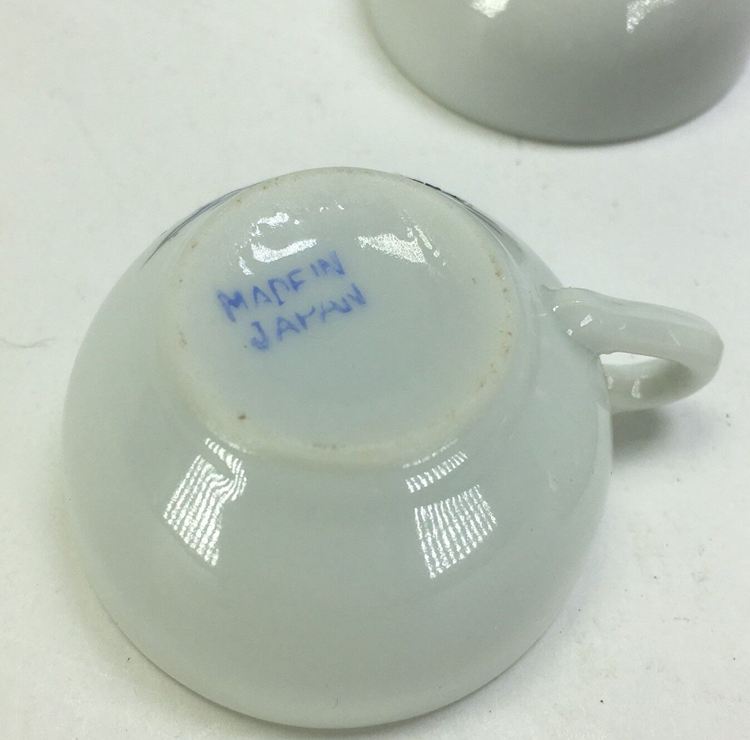
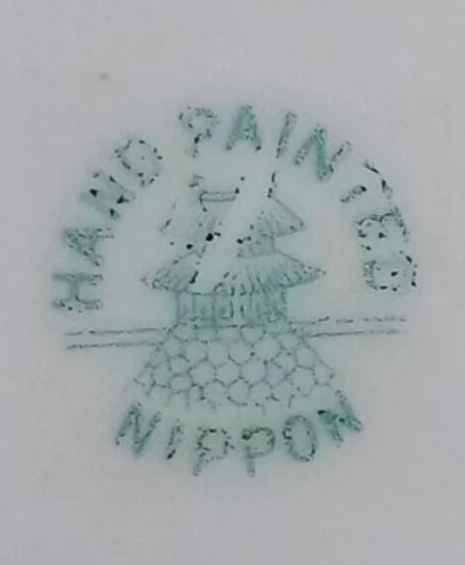
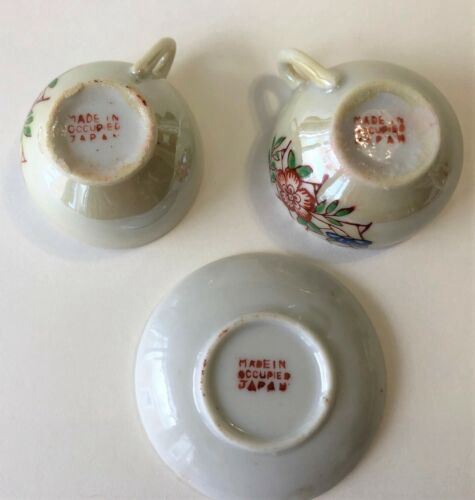




![Where To Sell Antique Furniture In 2022 [Ultimate Guide]](https://www.jacquelinestallone.com/wp-content/uploads/2022/09/Etsy-Your-Place-To-Buy-And-Sell-All-Things-Handmade-600x450.jpg)


